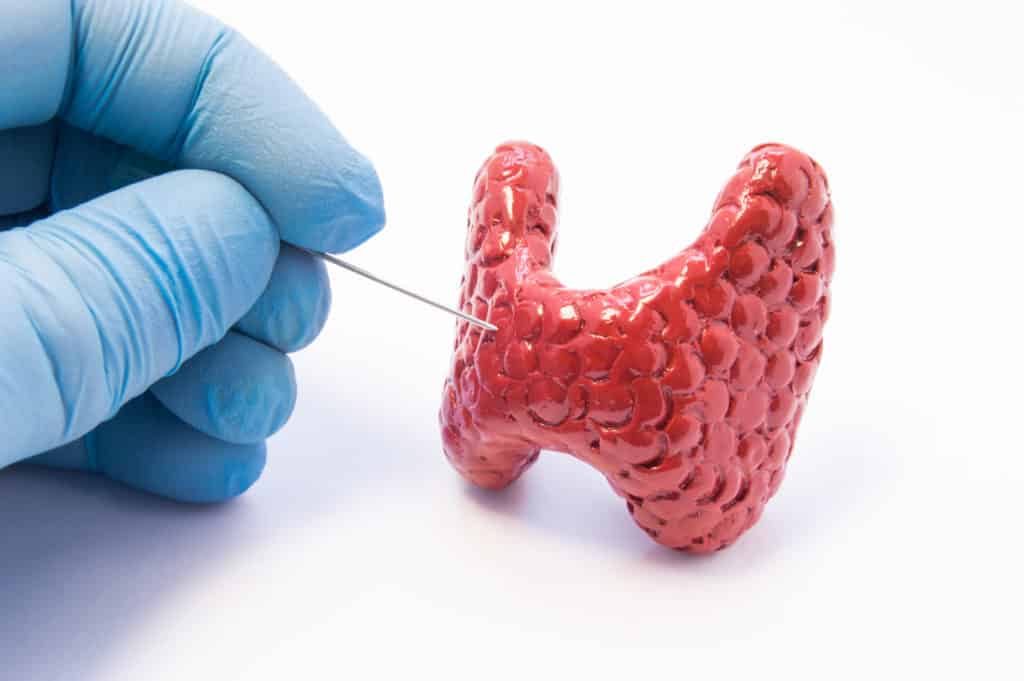Mutations in specific genes may predispose an individual to tumor formation and cancer. Genetic testing is available for certain types of cancer and can be used to confirm or rule out a diagnosis. Genetic and molecular testing can also help doctors choose targeted therapies and design a treatment plan.
Unfortunately, the final diagnosis of thyroid cancer is not obtained until after the thyroid nodule has been surgically removed. Ultrasound imaging and fine-needle aspiration (FNA) biopsies can, however, provide useful information for planning treatments according to the risk of malignancy associated with the nodule, and in some cases, may help prevent unnecessary procedures.
Thyroid nodules are generally detected by patients or by a physician during a routine physical exam. Nodules may also be discovered incidentally on unrelated imaging studies such as a chest CT scan, MRI of the cervical spine, or doppler ultrasound of the carotid arteries. In general, the standard diagnostic approaches for thyroid cancer are as follows: physical examination, imaging, blood tests, and if necessary, biopsy.

For thyroid nodules, FNA biopsy is used to sample a small number of cells for examination under a microscope to determine if the nodule is cancerous. The results of these biopsies are reported in a standardized manner using the Bethesda Classification System, which classifies nodules according to their risk of malignancy. Most nodules will be reported in a manner that indicates if the nodule is likely to be either benign or malignant. There are cases, however, in which the characteristics of the specimen are not clear enough to make a diagnosis of benign or malignant, and the case is deemed ‘indeterminate’. In these specific cases, genetic testing for specific molecular markers can help to clarify a nodule’s risk of malignancy, and thus plan the appropriate surgical treatment.
Molecular markers can be used to diagnose thyroid cancer, predict the aggressiveness of the disease, and predict the efficacy of certain therapeutic agents in treating each individual case.
Types of Genetic Mutations
A variety of types of genetic mutations may be present in thyroid tumors. Some of the most clinically relevant mutations include:
- BRAF
This is the most common genetic mutation found in thyroid cancers (typically papillary thyroid carcinoma). It is associated with aggressive forms of thyroid cancer, as well as a higher risk of recurrence. If a BRAF mutation is found in a thyroid nodule, the risk of papillary thyroid carcinoma is nearly 100%. - RAS
This is the second most common mutation associated with thyroid cancer, typically papillary or follicular thyroid carcinoma. - RET/PTC
This mutation is often associated with papillary and medullary thyroid carcinoma. - PAX8-PPAR
This mutation is often associated with follicular thyroid carcinoma.
If a genetic mutation is identified, doctors can guide a patient’s treatment in a more targeted manner. For instance, anaplastic thyroid cancer, a rare and aggressive type of thyroid cancer, contains a BRAF mutation. Once this mutation is detected, specific drug combinations that target the BRAF mutation can be administered. This approach leads to a more favorable clinical response than the standard, non-targeted treatments. Additionally, current research studies are constantly looking to identify more cancer-associated genetic mutations and test newly developed treatments to target such mutations.
Genetic Testing Techniques
There are a variety of genetic testing techniques that may be used based on the specific tumor and suspected mutation type.
- Polymerase Chain Reaction (PCR)
This process involves the amplification of a DNA sequence. It is used to identify mutations at known positions in a gene to confirm the presence of a suspected mutation. - Sanger Dideoxy Sequencing
This process copies target DNA sequences multiple times in order to create DNA fragments of different lengths. The ends of the fragments are then marked with fluorescent markers. These fragments are separated and ultimately used to provide the DNA sequence. Sanger sequencing is the most widely used method of detecting single nucleotide variants. - Multiplex Ligation-Dependent Probe Amplification (MLPA)
This is a specific form of PCR that distinguishes between sequences differing by only a single nucleotide (point mutations). - Fluorescence In Situ Hybridization (FISH)
In this technique, DNA sequences of interest are tagged with a fluorescent probe and visualized under fluorescent microscopy. This is useful for understanding chromosomal and genetic abnormalities. - Next-Generation Sequencing
This method is used to rapidly sequence entire genomes at a relatively low cost.
Who Should Have Molecular Testing?
The presence of thyroid cancer in two or more first degree relatives, or the rapid growth of a neck mass may suggest a genetic origin of thyroid cancer. These factors should lead a patient to ask their doctors about molecular testing.

Download This Section
Feel free to download and print this page.
It’s free for personal use and to share with others you think might benefit from the information provided.











